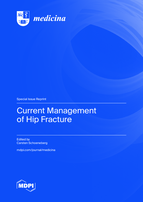Current Management of Hip Fracture
A special issue of Medicina (ISSN 1648-9144). This special issue belongs to the section "Surgery".
Deadline for manuscript submissions: closed (30 September 2022) | Viewed by 29664
Special Issue Editor
Special Issue Information
Dear Colleagues,
The incidence of hip fracture as a typical fragility fracture is increasing worldwide due to demographic changes and aging populations. Due to the patients‘ age, existing comorbidities, reduced daily life activities, poor bone quality, and preexisting implants, the treatment of hip fractures remains challenging. Therefore, proximal femur fractures are often life-changing events in older adults and are associated with high mortality rate, up to 35% after a year. Moreover, these fractures are associated with a decreased walking ability, reduced quality of life and loss of independence. Furthermore, hip fractures are associated with high socioeconomic costs, due to surgical complications, reduced coping capacities and high institutionalization rates.
These dramatic consequences have led to the development of optimized implants and the establishment of an orthogeriatric co-management. This concept indicates and includes multi-professional and interdisciplinary cooperation between surgeons and geriatrics. The advantages of such a cooperation are well documented by evidence in reducing mortality and complications. In addition, special national guidelines were established to provide best care of patients with a hip fracture.
Moreover, special geriatric hip fracture registries have been established in different countries. These registries enable the analysis of big data and have the potential to improve the treatment of geriatric patients with hip fracture.
However, in most of the countries worldwide, there is a large supply gap in the prevention of secondary fractures following fragility fractures. For example, in the United States, the prevalence of pre- and post-fracture anti-osteoporotic medication is beneath 25%. Similar results are reported from China, Italy, Germany and other countries.
The body of literature concerning hip fractures has risen exponentially in the past years. Nevertheless, due to divergent reported results, several questions remain unsolved: e.g., What are predictors for worse outcome? Are there easy to use predictor scores? What is the best time-to-surgery? What is the best implant for the individual patient? Should we perform cement augmentation? What is the best concept of orthogeriatric co-management? In addition to many more questions.
The purpose of this Special Issue is to discuss the evidence of the current management of hip fractures. Therefore, the scope is not tailored to only surgical strategies and the choice of implant, but should also focus on the whole process of treating patients after suffering a hip fracture. This includes epidemiology, process optimization, orthogeriatric co-management concepts, geriatric fracture centers, and secondary prevention of fractures. Even the analyses of the socioeconomic consequences are of interest. Moreover, the type of fracture is not limited to femoral neck fractures, but also included trochanteric and subtrochanteric femur fractures, proximal periprosthetic and periimplant fractures, and acetabular fractures.
Prof. Dr. Carsten Schoeneberg
Guest Editor
Manuscript Submission Information
Manuscripts should be submitted online at www.mdpi.com by registering and logging in to this website. Once you are registered, click here to go to the submission form. Manuscripts can be submitted until the deadline. All submissions that pass pre-check are peer-reviewed. Accepted papers will be published continuously in the journal (as soon as accepted) and will be listed together on the special issue website. Research articles, review articles as well as short communications are invited. For planned papers, a title and short abstract (about 100 words) can be sent to the Editorial Office for announcement on this website.
Submitted manuscripts should not have been published previously, nor be under consideration for publication elsewhere (except conference proceedings papers). All manuscripts are thoroughly refereed through a single-blind peer-review process. A guide for authors and other relevant information for submission of manuscripts is available on the Instructions for Authors page. Medicina is an international peer-reviewed open access monthly journal published by MDPI.
Please visit the Instructions for Authors page before submitting a manuscript. The Article Processing Charge (APC) for publication in this open access journal is 1800 CHF (Swiss Francs). Submitted papers should be well formatted and use good English. Authors may use MDPI's English editing service prior to publication or during author revisions.
Keywords
- hip fracture
- orthogeriatric co-management
- osteoporotic treatment
- geriatric fracture center
- fracture liaison service
- fragility fracture
- fracture fixation
- hemiarthroplastic
- total hip replacement
- hip fracture registry
- surgical complications







